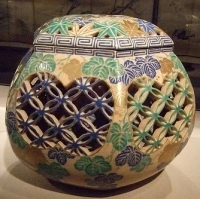
A hundred years ago a woman going out in the cold of winter could tuck a miniature hot water bottle inside her fur muff to keep her hands warm: like Maw’s Dainty Muff Warmer in the photo. This kind of hand warmer was on sale in late Victorian and Edwardian England.
The Thermos Hot-water Muff Warmer is a delightful little invention which is sure to be appreciated by my readers.
Ada Ballin, Womanhood, 1904
Poorer people had to find simpler ways of coping with a cold journey: heated stones or potatoes in a pocket, perhaps.
Ma slipped piping hot baked potatoes into their pockets to keep their fingers warm, Aunt Eliza’s flatirons were hot on the stove, ready to put at their feet in the sled. The blankets and the quilts and the buffalo robes were warmed, …
Laura Ingalls Wilder, Little House in the Big Woods (story of the early 1870s in Wisconsin)
The branded stoneware muff warmer was a new take on elegant ceramic or silver hand warmers that ladies’ maids filled when their mistress was about to set out on a cold carriage ride or walk. With carrying strings and tight stoppers, and optional fabric cover, these were clearly designed for people going out from home.
Hand warmers indoors

Hands could be cold indoors too. Plenty of people made good use of a hand warmer in a room or workshop with neither fireplace nor stove. Most parts of Europe had a variety of portable warmth providers, from silver braziers to ceramic novelties to heat-retaining bricks.
An earthenware pot with glowing charcoal was a common source of portable heat. It might be put on the floor, used as local heating or as a foot warmer, but it could also be raised up to warm someone’s hands -as in the picture. At night it could be used in a bed wagon.
Portable containers for hot water or glowing embers are sometimes called hand warmers even when they are used for more than just cold hands.
Pocket warmers
Neat little hinged cases with sticks of charcoal inside were in use in Europe by the first world war, when some officers carried pocket warmers. Someone patented a design in the US for a similar case holding heated metal slugs but I don’t know if these were ever made. There were also tubes to hold charcoal rods.

One of the newest inventions for winter comfort is a small hand warmer consisting of a hollow cylinder of fiber. A small pencil of heated charcoal is inserted through one end. The device will keep warm … for two hours.
Popular Science, USA, 1924
Chinese & Japanese handwarmers
You can’t really discuss antique handwarmers without mentioning the traditions of Eastern Asia.

Japanese homes might offer guests a small roundish ceramic pot with fuel in to warm their hands. Called a te-aburi , it could be used by an individual at the same time as a hibachi brazier big enough for a whole group of people.
Copper or bronze box-shape hand warmers a few inches across, often with carrying handles, were called shou lu in China: convenient, portable, with glowing coals inside. China and Japan had used both metal and ceramic hand warmers for many centuries. The perforations were an attractive part of the design as well as being functional. I like this tiny piece of Chinese pottery for warming 7th century hands.

European travellers in the later 1800s and early 1900s were interested in the little heaters they saw in the Far East. Some people called them “Japanese muff warmers” and recommended them for nursing and medical purposes. One Englishman bought one for his own winter outings and praised the:
…little stoves which the Japanese women put in their sleeves and obi [wide sash]. They are small enough to push up the sleeve of a [European] coat, and…will keep alight for four or five hours.
Walter Tyndale, Japan and the Japanese, 1910

These could be lit with a simple paper fuse in 1910, but it was not long before a modern version of the metal “box” hand warmer was introduced to Japan. It was ignited with platinum catalyst technology. The Hakkin hand warmer or kairo, invented in 1923, looks like a cousin of the cigarette lighter, but I like to think it was inspired by its older ancestors.
S. Maw, Son, & Sons
This English company’s Dainty Muff Warmer was by no means an important product. Maw’s had been dealing in surgical and pharmaceutical supplies from 1807 onwards. One of their early earthenware products was an inhaler (from the 1860s or before). By the early 1900s they were making ceramic foot warmers as well as hand warmers, and also baby feeders, toothpaste pots and more. The company name varied over the years. From 1901-1920 they were S. Maw, Son, & Sons of Aldersgate Street, London.
Photos
Photographers credited in captions. Links to originals and/or licenses:
German pocket warmer, Chinese warmer, Japanese warmer, Hakkin warmer, or see more picture info here.
Trying to find out if item Mecca Toot Warmer is for sale. If so how much and who do i contact please?
LikeLike
What’s up,I read your blog named “Hand warmers, muff warmer, antique hot water and charcoal holders — Home Things Past” daily.Your humoristic style is witty, keep doing what you’re doing! And you can look our website about proxy list.
LikeLike
Très bon article. J’aime bien souvent votre site internet
LikeLike